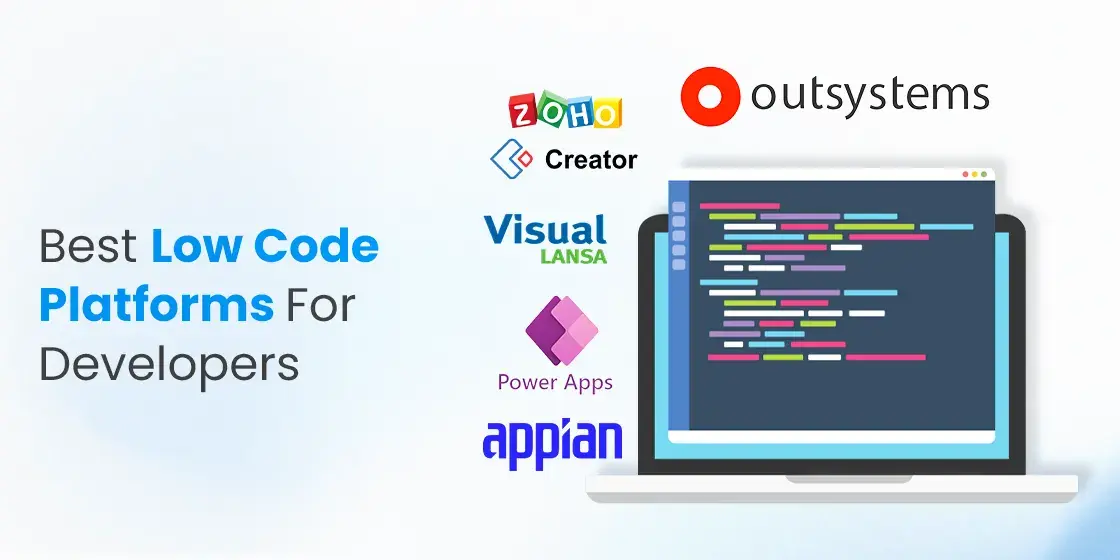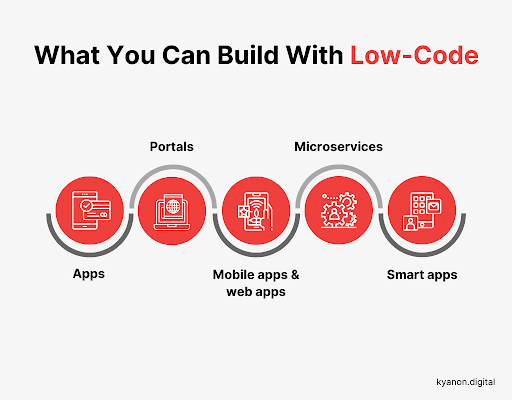Low-code app development has many advantages, specifically in terms of integration. This is crucial to create applications that seamlessly connect to systems and other services. Here are the key benefits: Pre-built Connectors and APIs
A Wide Variety of Connectors: Low-code platforms typically come with a vast library of pre-built connectors to common enterprise software (e.g., ERP, CRM and cloud services such as databases,). This simplifies integration with the systems.
API Integration - Many low-code platforms come with API integration, allowing developers easy access to other data sources or external services.
Easy to Utilize:
Integrations with Drag-and-Drop Integrations can be created using drag and drop interfaces. Both developers and non-developers are able to accomplish this without having to write extensive code.
Visual Workflow Builders Visual tools to design workflows and data flow aid in understanding and setting up integrations more intuitively.
Standardized Integration Methods:
SOAP and RESTful Services Support for web service protocols like REST and SOAP allows for easy integration with a variety of external software and systems.
OData Other Standards: The support for standards like OData facilitates the access and manipulation of data across applications and platforms.
Real-Time Data Synchronization:
Real-Time Integrations: Lowcode platforms manage data synchronization in real time between applications and system, ensuring data is always up-to-date and consistent across the company.
Event-Driven architecture: Certain platforms support event-driven architectures. This allows applications to respond to events in real-time that is vital for interactive and dynamic applications.
Legacy System Integration:
Low-code platforms are a great source of software to connect with existing systems. They let organizations modernize IT without overhauling their existing systems.
Data Migration Tools: The built-in tools to migrate data facilitate the transfer of old systems to software developed using low-code platforms.
Third-Party Service Integration:
Cloud Services: Integration with cloud services like AWS Azure and Google Cloud allows easy deployment and scaling.
Business Applications Integration Lowcode platforms are used to integrate various business applications including Salesforce, SAP, Microsoft Dynamics etc. to create a seamless workflow among different business functions.
Simplified Data Management:
Unified data models: A few platforms provide low-code support unified data model to simplify data management across systems.
Data Connectors: Data connectors that are pre-configured to provide easy access and manipulation of data derived from various sources.
Security and Compliance
Secure Integrations Low-Code platforms are designed to make sure that integrations adhere to security protocols and standards. This ensures the security of data both in transit and when it is stored.
The platforms have features to ensure that integrations meet regulatory requirements (e.g. GDPR, HIPAA), giving businesses who handle sensitive data security.
Extensibility:
Low-code platforms often meet complex integration requirements by adding custom scripts or code. They offer flexibility without compromising the user-friendliness.
Plug-in Ecosystems: A plug-in ecosystem can be used to expand the integration capability, and allow users to add more features when needed.
Low-code platforms provide a powerful instrument to create interconnected effective and scalable applications. They are able to streamline the process of connecting disparate systems, and increase data flow. Companies can leverage existing technology and implement new ones, while ensuring a seamless IT environment. Take a look at the best one-time offer about Low-code Platform for application development for website tips including develop mobile application, develop web app, jdbc server, stored sql procedures, app modernization, rad development, push alerts, app modernisation, app modernisation, cross platform mobile app development and more.

The Benefits Of Low-Code Application Development In Governance And Security
Low-code applications provide a number of advantages for governance and cybersecurity, which is crucial to ensure that all apps are managed, well-managed, and compliant throughout their lifecycle. Here are some of the most important benefits:
Unified Management Console: A low-code platform often provides a centralized dashboard that administrators can use to control and monitor all applications and ensure that the governance is consistent across the entire organization.
Role-Based Access Control RBAC: These platforms are equipped with robust controls based on role that allow administrators to set access rules. Only authorized users are able to modify or access certain parts of a program.
Compliance and Regulatory Adherence
Built-in Compliance Features: Many low-code platforms are designed to comply with industry norms as well as regulations (e.g., GDPR, HIPAA). They offer tools and frameworks which help ensure that apps meet the requirements of these regulations.
Audit Trails and Logging Complete audit trails and logging are often integrated, allowing companies to track changes, monitor access, and ensure compliance with internal and external laws.
Additional Security Measures
Data encryption. Low-code platforms offer encryption for data at rest as well as while it is being transmitted to ensure that sensitive data is protected.
Security Certifications Many low-code vendors have security certificates (e.g. ISO 27001, SOC 2 ) that demonstrate compliance with high security standards. This gives additional security for the customers.
Automated security updates:
Regular Patching and Updates Lowcode platforms generally handle regular security updates. These patches guard software from the latest threats without requiring the involvement of developers.
Security Monitoring Tools: These instruments send alerts that are updated in real time, and provide insights into security concerns that might be present.
Data Governance:
Data Access Policies These systems allow organisations to create data access rules and enforce the policies, making sure that the data is only accessible to those who have been granted access. They also ensure that the data is used correctly.
Data Masking and Anonymization Tools built in for data masking & anonymization safeguard sensitive data, particularly in testing environments and development environments.
Consistent Lifecycle Application Management:
Pipelines for development and delivery: Low-code platform often include integrated development pipelines and delivery pipelines that incorporate security tests. Security is ensured throughout the entire lifecycle.
Version Control: Integrated version control is a way to manage modifications and makes sure that modifications to the application can be tracked and reverted if necessary, maintaining the integrity of the application.
User Authentication Authorization
Single Sign-On Support for single sign-on (SSO) and other advanced methods of authentication simplify management and enhances security.
Multi-Factor Authentication (MFA): Many platforms offer built-in support for multi-factor authentication. It adds an extra layer of security for accessing applications.
Policy Enforcement Monitoring and Compliance:
Low-code platforms usually come with pre-defined policies templates that enable organizations to implement governance and cybersecurity policies quickly.
Compliance Monitoring Tools: These give continuous monitoring and a report on the status of compliance. This makes it easier to detect potential issues and address them proactively.
Integrate with the existing security infrastructures:
Seamless Intergration: Low code platforms are designed for seamless integration with existing security tools and equipment, including Identity Management Systems SIEM Solutions (Security Information and Event Management), and Firewalls.
API Security: Built-in API security features ensure that integrations with other systems are safe, safeguarding data and maintaining application integrity.
Best practices and Training
Guided Best Practices: A number of platforms offer guidelines and best methods for secure application development that help developers who are not developers to adhere to security standards.
Security Training Some low code providers offer security tools and training for users to teach them how to build and maintain secure applications.
In general, low-code developers have a security and governance advantage which allows them to create and manage applications in a controlled, regulated and secure way. These platforms contain the tools and frameworks needed to supervise and control application development processes, secure sensitive data, while ensuring the compliance of regulations and enforcing rules. Follow the recommended wavemaker.com coding for website examples including app platforms, develop cross platform mobile app, mobile development platforms, develop web app, push alerts, cross platform app dev, microsoft azure sql, develop mobile application, application modernization, cloud software applications and more.

The Benefits Of Low-Code Programming For The Development Of Applications, In Terms Of Limitations And Customization
Low-code applications are a flexible, balanced approach that addresses limitations and allows for customisation. These are the main advantages: Handling limitations
Beating Complexity Barriers
Development simplified: Low code platforms make it easier to develop by providing templates and pre-built elements. This allows faster application deployment, even for complex ones.
A lot of platforms come with wizards and workflows that are guided to help developers navigate difficult procedures. These tools decrease the chance of making mistakes, and help ensure uniformity.
Scalability Solutions:
Scalability is built in: Low-code platforms often include capabilities that permit the development of scalable architecture. Applications can handle increased demands with little changes.
Performance Monitoring: The tools which monitor and optimize performance can help make sure that applications run efficiently even as they expand.
Security and Compliance:
Integrated Security Features : Low codes platforms have security features that are built in, such as encryption and access control based on role. They also perform automated checks for compliance to identify security issues.
Regular Updates: Platforms frequently update their security protocols and compliance measures, ensuring that applications remain secure against new threats.
Customization Capabilities:
Extensibility:
Custom Code Integration: Low-code systems usually permit the integration of custom codes (e.g., JavaScript, Python), enabling developers to enhance the functionality beyond the standard offerings.
Custom Modules and plugins: Developers have the option of creating custom modules or plugins to modify specific functionality to fit unique business needs.
APIs and Integration
API Support: A comprehensive support for APIs allows seamless integration with other systems and services, which allows the creation of a wide range of customizations and connections.
Third-Party Services: Low-code platforms typically have pre-built connectors to popular third-party services, making it simpler to integrate and customize applications.
Flexible UI/UX Design:
Customizable User Interfaces: Designers can alter and design user interfaces that are in line with the specifications for branding and usability, creating a tailored user's experience.
Responsive design: The capacity to adapt applications to different screen sizes and devices is built-in.
Business Logic Customization
Visual Workflow builders They allow developers to build complex processes with minimal or no programming. They can create business processes and workflows visually.
Conditional Logic & scripting: Platforms allow for the application of conditional logic and custom scripting for handling particular business rules.
Data Management:
Custom Data Modeling: Designers define custom models to fit specific requirements for the particular application. They can customize the handling of data to meet business requirements.
Advanced Data Processor: The integration of sophisticated data processing tools and capabilities allows the customization of how data is processed and used in the application.
Balancing Limitations with Customization:
Frameworks and Standards
Best Practices: Low-code platform encourages compliance with standards and best practices in the industry. This can be helpful in maintaining high quality secure, scalable, and scalable applications.
Governance Frameworks. The built-in governance frameworks ensure that any modifications are not detrimental to the integrity, security or the compliance of an application.
Iterative Development:
Rapid Prototyping. Developers can iterate and improve applications based on user feedback.
Low-code platforms allow for constant improvement through continuous customization and further enhancing the platform as requirements of business evolve.
Empowering Users
Empowering Citizen-Developers: Low-code platforms increase the number of contributors capable of enhancing and customizing applications, by permitting them to create custom an intuitive user interface.
Training and Support Resources: Many platforms provide extensive training and support materials to allow users to customize their applications without jeopardizing their stability or performance.
Low-code development is a powerful framework that offers a wide range of flexibility while also addressing limitations. This balance lets businesses build and maintain functional applications that are tailored to their specific needs, while ensuring high standards of quality, security and the ability to scale.
